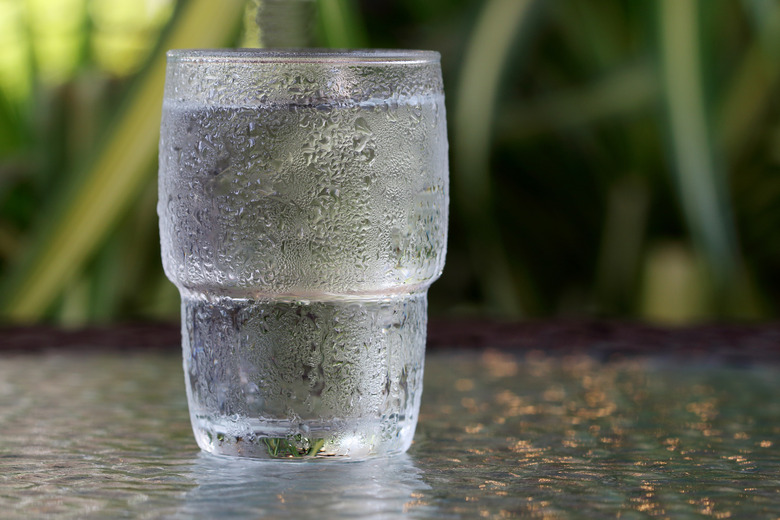Water Cycle Project Ideas
Water makes the world go 'round, so there's hardly a more critical subject to tackle for a school science project. Whether it's demonstrating the water cycle, exploring evaporation or tracking precipitation, there are many interesting ways to display how the water cycle functions.
Water Cycle Demonstration
Water Cycle Demonstration
One of the best ways to learn about the water cycle is to see it in action. A demonstration can display all four steps of the cycle: evaporation, condensation, precipitation and collection. Although we technically see the results of the water cycle at work in our daily lives, this demonstration provides a visualization where the water cycle happens in just one container.
Start by filling a clear container about 1/4 of the way full with hot water. (The heat isn't a necessary step, but it helps the water evaporate faster.) Add several teaspoons of salt to mimic the saltwater of the oceans. Place a smaller container inside the larger container. Position the smaller one so that it sits higher than the surrounding saltwater and remains empty. This container eventually collects the "rain" water.
Cover the container tightly with clear plastic wrap. The wrap plays the role of the clouds hovering above Earth, and provides a place for condensation to gather.
On top of the plastic wrap, set a few cubes of ice. The ice cools down the "clouds," causing the saltwater from below to evaporate and condense on the plastic wrap after rising.
Wait for the ice to melt. The amount of waiting time depends on how hot the water was when you started, as well as the room temperature, but it could be anywhere from a few minutes to an hour. After some time, you should see condensation beneath the "clouds," or the icy plastic wrap. Next, precipitation starts. Through the clear sides of the container, you should be able to see tiny "raindrops" of condensation falling into the smaller container.
If you used clean water, you can go ahead and take a sip from the smaller container. It shouldn't taste like salt. Even though the "ocean" water was full of salt, the salt evaporates along with the water that condenses beneath the plastic.
In just a few easy steps and one clear container, you created the water cycle.
Water Cycle Project Poster
Water Cycle Project Poster
If you don't have the materials to perform a demonstration, a graphic on a poster provides a visualization of all the steps in the water cycle.
Include all the steps, without numbering them. Instead, a series of arrows laid out in circular form indicates that the water cycle is in constant motion.
While a demonstration only displays how rain forms, a poster also offers a way to draw the different types of precipitation, including snow, sleet, freezing rain and hail.
It can also show some of the more nuanced parts of the water cycle, such as transpiration. That's what happens when plants absorb water through their roots. The water then evaporates as a vapor through pores in the plant's leaves. Leave enough space between each arrow for the step it represents in the cycle and the graphics you chose to utilize.
Water Cycle Project Model
Water Cycle Project Model
A three-dimensional diagram provides still another way to visualize how water moves in its various forms to sustain life on Earth.
Start by making a flat base. Attach cardboard at a 90-degree angle to the base using two box lids or thick cardboard. This can also be done within an open shoe box. Use those surfaces to create the lifelike world that demonstrates the water cycle. On the surface that points upward, add a sun, clouds and a blue sky. On the surface that lays flat, create three dimensional formations such as mountains, trees and oceans from cardboard cutouts.
Plenty of materials can make novel additions to the water cycle model. Make clouds from cotton balls or white balloons. Fashion the sun from clay, and oceans in a small container of salt water. You can also use true-to-life objects. Head outside and grab some sticks, leaves or rocks to put together tiny models of trees or mountains. If you have the equipment on hand, you could also make the entire diagram out of Legos.
Within the diagram, label each step of the water cycle. If you have room, you can also include a a brief statement with a description of each part of the cycle. Include arrows or another symbol that indicates the cyclical nature of water's journey on Earth.
Cite This Article
MLA
Dragani, Rachelle. "Water Cycle Project Ideas" sciencing.com, https://www.sciencing.com/water-cycle-project-ideas-13710535/. 27 March 2018.
APA
Dragani, Rachelle. (2018, March 27). Water Cycle Project Ideas. sciencing.com. Retrieved from https://www.sciencing.com/water-cycle-project-ideas-13710535/
Chicago
Dragani, Rachelle. Water Cycle Project Ideas last modified August 30, 2022. https://www.sciencing.com/water-cycle-project-ideas-13710535/
